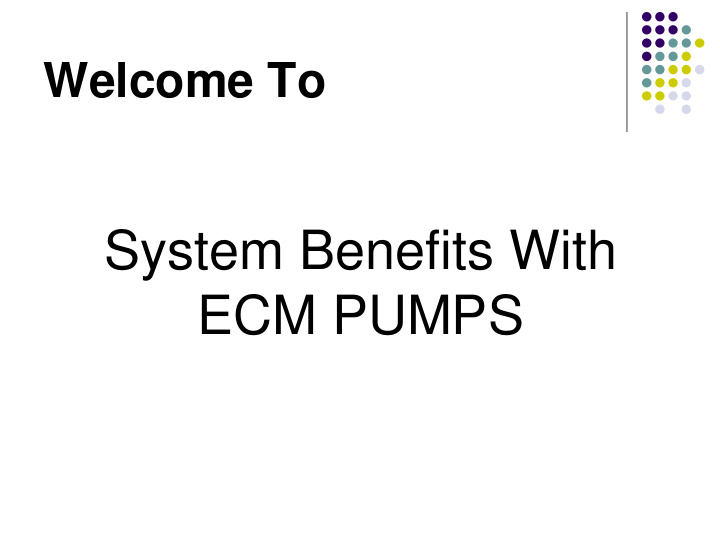



Welcome To System Benefits With ECM PUMPS
Hydronic System Efficiency Should we be focusing on more than just the heat source? 2
The hydronic heating industry has put there main focus on the heat source with a series of innovations.
Boiler Advancements Stack heat recovery units Automatic vent dampers Electronic ignition Increased jacket insulation Condensate heat recovery (condensing boilers) Variable speed fans (modulating boilers) Increased turn down rates As of 9/1/12 DOE mandated boilers to have automatic temperature control (outdoor reset control)
Changes in piping design targeted at the Heat source Injection piping with outdoor reset control Buffer tanks to keep boiler from short cycling Hydraulic separators for proper flow through boiler
Alternative Heat Sources Geothermal Solar Wood Corn/pellet Boilers
What about the method and cost or efficiency of delivering that heat? Can we make circulating the heat more efficient? Do we need to?
Pumping systems account for 22% of the world’s electrical power demand Air Compressors 18%, Fans 16%, Cooling Compressors 7%, Other equipment 37% Centrifugal and axial pumps account for 73% of all pumps Over 95% of all pumps are oversized due to multiple butt covering!
Heating Basics – Pump Sizing You need to know… FLOW BTU output of the boiler(s) for the primary pump(s) and loop loads for secondary pump(s) Design temperature differential (delta T) – dependant on application, local climate Calculate flow based on laws of thermodynamics (definition of a BTU) GPM = BTU/Hr. Divided by delta T x 500 Calculate: Flow for 300,000 BTU/Hr.@ 20 degree F design differential(delta T)? 30 Usgpm
Heating hours per season Barrow, Alaska 20,370 hrs. Outdoor temp 36 Bismarck, N.D. 8,932 hrs. Outdoor temp -16 Hilo, Hawaii 0 hrs. Outdoor temp 63 Kansas City, Mo. 5,326 hrs. Outdoor temp 4 Key West, Fl. 68 hrs. Outdoor temp 58 Yuma, Arizona 983 hrs. Outdoor temp 44 St Paul/Mpls MN 5751 hrs. Outdoor temp -11 Manual J Outdoor Design Temp
Do we need the same amount of BTU’s/Hr? Would we design for the same outdoor temperature? How many hours of each season would be at design temperature?
30 year Average For Twin Cities
Coldest design day Temperature The coldest day of the year is 2 % of the total operating period
But how is the system working during the remaining 98% of the operating period?
Should we be focusing on more than just the heat source? What about the method and cost or efficiency of delivering that heat? Can we make circulating the heat more efficient? Do we need to?
Pump Affinity Law Note! If the speed of a pump is increased by 10% the volume flow increases by 10% the head increases by 21% the power increases by 33 % Example: Slowing a pump from 1800 rpm to 1200 rpm results in a 33% decreased flow, 66% decrease in head and 70% decrease in power.
Heat Distribution Efficiency How many Btu's/hr. are being delivered per watt being used Btu’s/hr. divided by total watts being used by circulators Example: 100,000 Btu/hr. boiler & (1) .5 amp 115v pump system .5 amp x 115v = 60 watts divided by100,000=1,666Btu’s/hr. per watt used If we use a 30 watt pump divided by 100,000=3,333Btu’s/hr. per watt used Now imagine multiple pump systems!
VFD’s are one solution to the energy consumption of pumps Up to 80% energy savings can be achieved using proper VFD techniques The pump can run closer to it’s best efficiency point But Is It worth the expense to modulate the speed of the pump?
Benefits of a variable speed pump with an ECM motor Electrical usage savings System performance Heat source efficiency Comfort
ECM (Electronically Communicated) technology (ECM) Electronically Commutated Motor High efficient brushless DC programmable motor Pump uses a permanent magnet rotor. DC motors are significantly more efficient across a range of speeds than AC motors Soft starts save wear and tear on system components Reduced noise and longer life
ECM (Electronically Communicated) Pump Technology Smart pump, flow controlled by pressure changes at the impeller Can be dead headed No external sensors needed. Pump can be programed to run at a constant head pressure. Pump can be programed to run at a variable head pressure. Pump can be checked to fine tune so its running as efficient as possible
Presentation without Demonstration is only Conversation
Recommend
More recommend